|
|
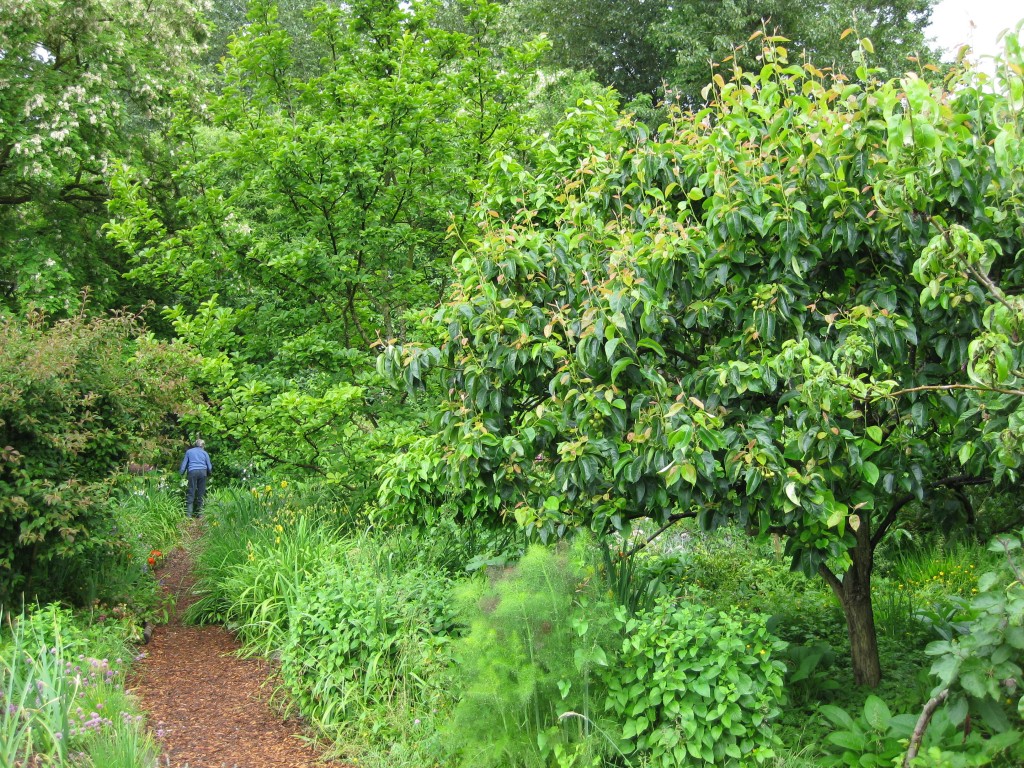 a green oasis Sometimes a bad idea just won’t go away. Though Vancouver’s future has been looking a lot greener lately, with the expansion of bike lanes and improved municipal composting, I was dismayed to learn that a city-proposed road expansion is threatening to wipe out Cottonwood Community Gardens, one of the Vancouver’s best-known examples of citizen-initiated urban greening. As a founder of Cottonwood, twenty-one years ago, I have fought this fight before.
Back in 1991, I started a campaign with a rag-tag group of East Vancouver residents to take over a three acre strip of city land on the southern perimeter of Strathcona Park, which had become a study in urban blight. The city had stopped enforcing anti-dumping bylaws in this industrial neighbourhood and mountains of jettisoned construction debris, landscaping waste, rotten furniture and junked cars were continuing to accumulate on the property with no end in sight, accompanied, unsurprisingly, by an increase in the rat population and the incidence of petty crime.
Tired of this officially sanctioned neglect, our little group of volunteers rolled up its collective sleeves, borrowed some wheelbarrows and shovels and got busy. With an enormous amount of hard work and a sense of community pride, we gradually transformed this unprepossessing piece of urban wasteland into an award-winning public garden and arboretum. It is without doubt one of the things in my life I am most proud of having done.
We called the place ‘Cottonwood Community Gardens’ as a nod to the giant cottonwood trees that tower over its northern edge, their rustling foliage a reminder of the area’s rich ecological past, when it was the marshy edge of False Creek, which once extended as far east as Clark Drive.
When word of our initiative got up to City Hall, we were informed that City Engineering had made plans to turn the dusty lot into a heavy equipment training area, despite being right beside a major park with heavily used playing fields, to which the dust churned up by the machinery would surely have drifted.
But those were the days of ‘recreational apartheid’ in East Vancouver, when the right-wing, Non-Partisan Alliance dominated city council and played favourites with the prosperous areas of the city that voted for them while turning their backs on neighbourhoods (like ours) that didn’t. The NPA dominated Parks Board was at that time busy assembling million dollar beachfront properties for parks in Point Grey and Kitsilano, while neighbourhoods on the East Side had to grovel to get broken teeter-totters replaced in their over-used inner-city playgrounds.
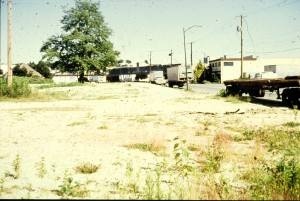 What we started out with
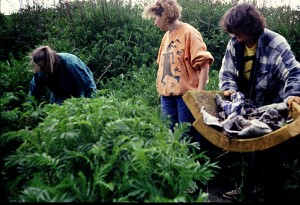 cleaning up
And if that wasn’t enough reason to continue with our intervention, a friendly Vancouver Sun reporter had tipped us off that City Engineering was quietly hatching a plan to build a major new truck route through the nearby Grandview Cut and run it right through this ignominious little property, funneling yet more smoke-belching transport trucks into our already polluted and congested environs.
Clearly City Hall was making some terrible decisions at the expense of the neighbourhood, so we needed to act fast. Whatever automatic legitimacy they may once have had was eroded by the pernicious neglect with which they treated the area, offering it up as a kind of sacrifice zone for their 1950’s vision of a vehicle-dominated city.
The ensuing work was very hard. We pulled out dumpster loads of every kind of disgusting trash imaginable – piles of moldy drywall, engine blocks, bloody syringes, used condoms – even a dead cat in a plastic bag – before we could do much actual gardening. And once we had dealt with all that insalubrious garbage, we hauled in wheelbarrow loads of rotten vegetables, gleaned from the produce warehouses on nearby Malkin Avenue, to make compost to enliven the impoverished soil. To water our initially meager crops, we had to haul buckets from the public washrooms in the park or wait for the rain to eventually fill them.
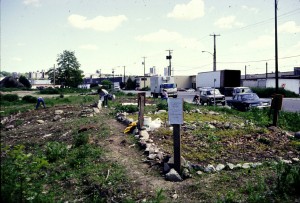 building the garden
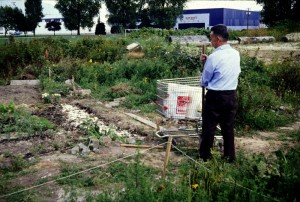 composting with salvaged tofu
Yet we persisted, and despite some initial push-back from a few NPA councilors and some grumbling from City Engineering, we managed to prevail and marshaled the considerable public support we had been generating into a long-term lease. This gave us the security and the legitimacy we needed to get some small grants, with which we bought a few tools, installed an irrigation system, a greenhouse and a garden shed. The Environmental Youth Alliance joined our effort and soon started transforming the eastern flank of the property that had been covered in dense, trash-filled thickets, into what would become a thriving centre for youth-focused environmental education.
Gradually but steadily, the sun-baked and squalid expanse of dust and garbage we started out with gave way to groves of exotic trees and carefully tended allotments. The sounds of unfamiliar birds started to fill the morning air and there were cool pockets of shade with benches, where weary passers-by could sit and enjoy the slow resurgence of nature.
Two decades later, Cottonwood Gardens stands out from its surroundings as an oasis of biodiversity, a verdant interruption to an otherwise dreary vista of sterile playing fields and low-rise industrial buildings. A few years into our project, a pair red-tailed hawks built a nest in one of the large cottonwoods only to get evicted, a few seasons later, by a pair of bald eagles that still are there today, their sprawling twig nest and squeaking eaglets adding to the Edenic vibe of the place. I’ve often caught sight of visitors to the garden stopping and staring, incredulously, as these majestic raptors soar over the heat haze that simmers up from the factory roofs and then alight high on one of the cottonwoods to feed their young. It’s just not what you’d expect to see in what was long one of the city’s most deprived and green-space deficient districts, and yet even this is still relatively early in the long process of ecological recovery and one can only wonder what might eventually be possible – if, that is, we are allowed to continue with our long-running experiment in community ecological repair.
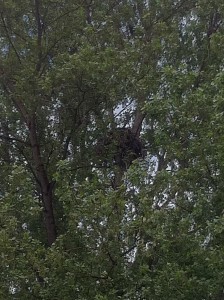 eagle’s nest
The seedlings and saplings we fussed over and watered all those years are now mature trees – a rich variety of them such as the blue-flowered Empress trees I grew from minuscule, milkweed pod-like seeds I picked up from under a gnarled, old specimen that still survives in Thornton Park. There are multiple kinds of mulberries, edible chestnuts, persimmons, Asian pears and groves of rare bamboo, along with extensive plantings of native species; all of them chosen for their ethno-botanical significance to the diverse heritage of the surrounding neighbourhoods.
In their well-tended garden plots, people from all walks of life coax forth a bounty of blooms, fruits and vegetables from what was once sterile rubble, sharing the food and recipes with their friends and neighbours in a living paradigm of what a green, inclusive city is supposed to be. This is an ‘open-source landscape’ that continuously evolves as a function of those who participate in it, with no real need for the top-down ministrations of bureaucrats, engineers and other members of the professional class. Cottonwood has always just run itself, a self-declared ‘autonomous zone,’ which is its true beauty but also makes it a threat to those who have a vested interest in maintaining the traditional power relationships that have controlled the evolution of the city.
Despite some headwinds at the start, Cottonwood has mostly had a cordial relations with civic politicians of all political stripes, and it didn’t take too long for even our foes to realize that the garden, which is essentially self-maintaining, creates environmental benefits and opportunities for community-building far beyond what is possible within the traditional parks system – at almost no cost. Cottonwood has been a very good deal for the city. With the rise of Vision Vancouver and their explicit advocacy of urban agriculture, I thought we were home free. During the last civic election, they even featured Cottonwood on their party web site as a prime example of a successful policy.
Imagine my shock then, when I found out last month that Cottonwood – despite all the accolades, the myriad hours of embodied volunteer energy and the many politicians who have schmoozed with us there, getting their pictures taken with babies and flowers – is once again on the chopping block, threatened by the same road, (though it’s now called a ‘super road’) we fought off all those many years ago. I was doubly surprised to learn that Vision Vancouver was behind the new spin on this same bad, old idea.
So how did we get into this ‘déja vu all over again’ situation?
Over the past year, Mayor Robertson and the rest of the Vision organization have been publicly promoting the removal of the Georgia and Dunsmuir Viaducts, a pair of concrete flyovers that are architectural relics of a proposed downtown freeway that got quashed by public outcry during the 1970’s. Though ridding the city of these monuments to twentieth century car culture might seem like a swell idea, (I got so excited about it, I even proposed to re-purpose them into a Highline style elevated garden), their removal will initiate a cascade of outcomes, not the least of which is that a substantial acreage of valuable real estate, now languishing as parking lots beneath the viaducts’ perpetual shadow, will get ‘day-lighted’ and hence available for development.
The viaducts, though not a freeway as such, do convey a substantial amount of traffic via Prior Street, a busy arterial that runs through the rapidly gentrifying Strathcona neighbourhood. Against the background of the viaducts’ proposed removal, the Strathcona Residents Association initiated a vociferous media campaign to get traffic calmed on Prior, to which the mayor responded with a proposal to build a so-called ‘super street’ that would divert much of Prior’s volume onto a newly widened Malkin Ave, whose right-of-way happens to pass right through the middle of Cottonwood Gardens. So we’re right back where we started from 21 years ago, only this time with a lot more to lose.
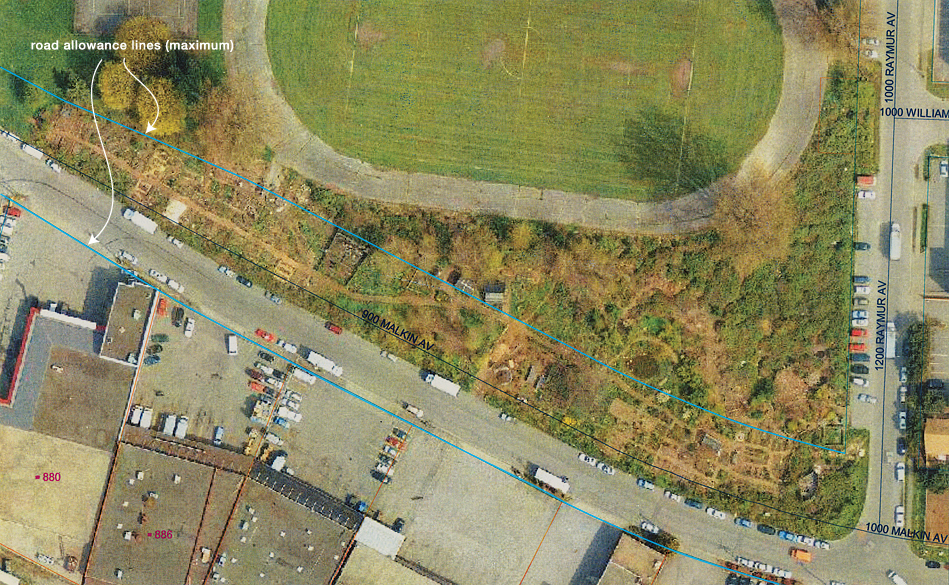 map showing road allowance
It has to be said though, the SRA has some valid arguments about the perils of Prior. It is a fast moving, high volume street with all the attendant traffic casualties, pollution and noise one might expect; hazards it shares with other high volume arterials in the area, where commuter and commercial traffic is routed through residential zones, as is the case with 1st Ave., 12th Ave., and a large section of Knight Street. To add to the complexity, the Province newspaper reported that traffic calming on Prior could add an average of $100,000 to the property values there, a not inconsequential outcome in a neighbourhood where real-estate prices have already skyrocketed.
Though this muddies the waters somewhat, it doesn’t negate the SRA’s safety concerns, but further underscores the need for Vision to step up with a much more innovative solution than the robbing Peter to pay Paul approach they have thus far hinted at, sacrificing Cottonwood, by now one of the city’s best-known ecological landmarks, for the uncertain outcome of traffic re-routing. Even without the Malkin ‘super street,’ the city itself anticipates the removal of the viaducts alone could actually contribute to a moderate decline in vehicles on Prior St.
as today (they) act as a magnet for commuter traffic with some commuters going ‘out of their way’ to access the viaducts via Prior St. With (their) removal, a significant proportion of commuters will naturally redistribute to other routes.
So the entire Prior issue may in fact be a red herring, with no real connection to what happens along Malkin except to add an unwarranted hysteria to the decision making process that plays nicely into the hands of the pro-development lobby.
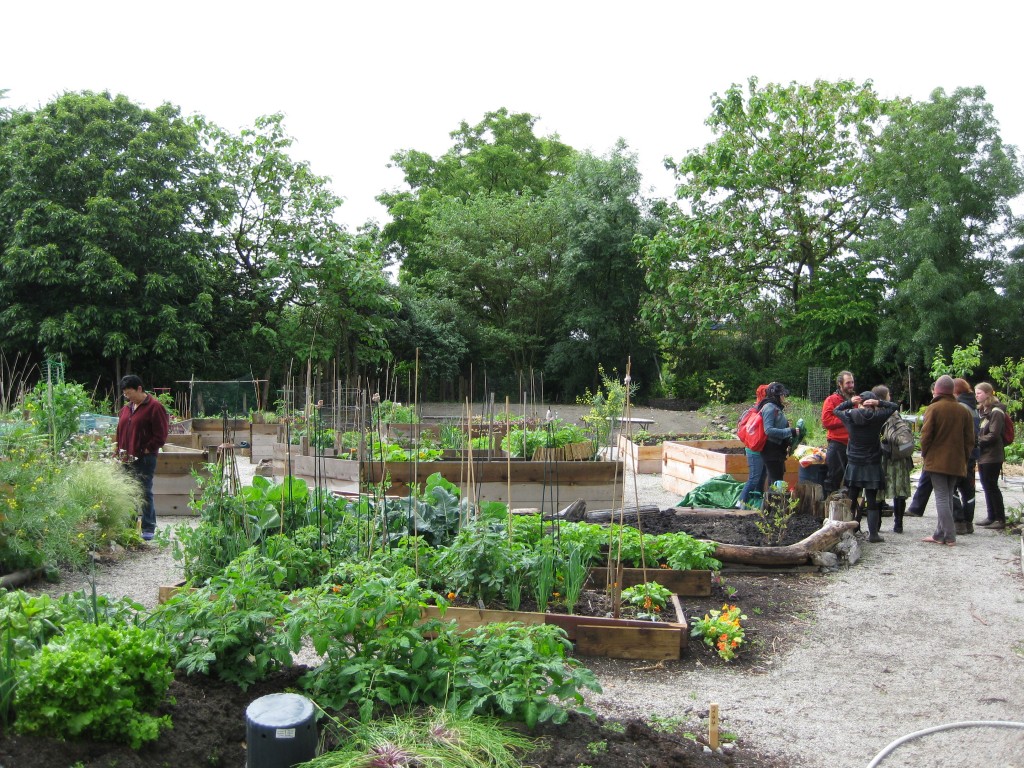 a recent upgrade to enhance accessibility Along with the local concern about the viaduct removal and its effect on Prior, there is massive pressure being exerted by the federal and provincial governments, who are pushing a multi-billion dollar ‘Pacific Gateway’ program to expedite truck and rail traffic into and out of Vancouver’s port, with the aim of facilitating Canada’s growing trade with the Pacific Rim. The widening of Malkin has already been floated by City Engineering as a desirable way to meet these goals along with an overpass to ease the indignity of traffic jams at the at level crossing on Prior.
While Vision has not yet announced a decision on what they have already christened the ‘Malkin Connector,’ there is a creeping air of inevitability to their public communication on the subject. Mayor Robertson has made it clear he wants to expedite the matter and on a recent CBC ‘Early Edition’ interview, Vision councilor Geoff Meggs showed an alarmingly wishy-washy attitude toward Cottonwood and its future, telling his audience that Malkin has ‘always been seen as a future major arterial’ for ‘improving goods movement, (and that) ‘there will be impacts’ so that ‘the area can be set up properly (emphasis mine) to support jobs and development opportunities.’ These are the chosen words of an individual who has already made up his mind, though Meggs did add, rather noncommittally, the garden will be given ‘serious consideration,’ which is not, on its own, hugely encouraging.
In the end though, what we have here is not so much of a political issue, but a problem of urban design, which therefore should be solvable, if enough creativity and resources are directed at it. A ‘win-win’ outcome here would be a huge boost to Vision’s green credibility and give a clear signal they were serious about moving away from the traffic-centric, development driven, business-as-usual approach to running the city that has been so prevalent in the past.
Conversely, it would be wrong-headed in the extreme for Vision to sacrifice Cottonwood for the sake of a ‘super roadway,’ no matter how highly the engineering department recommended it. Given the by now iconic nature of this garden, I can pretty much guarantee there would be massive protest should it come down to the bulldozers moving in, and the spectre of photogenic young environmentalists and outraged senior citizens chaining themselves to the garden’s greenery to ward off city road-building crews would be death to Vision’s green brand and a gift to the right-wing forces so eager to unseat them.
So Vision had better come up with a solution that lives up to its party name – an imaginative solution that doesn’t pit neighbour against neighbour or trash this beloved oasis of urban nature – for the sake of vehicles. A world-class, ‘green’ city deserves world-class design that is both environmentally and socially at the cutting edge – a standard that may be beyond the tired, old orthodoxies the traffic engineers have had to offer. We can’t let Vision cut corners here, despite mounting pressures on them to do so from some very powerful players. But will they have the foresight and creativity to get this right? There is a lot riding on the outcome. Vision got a substantial mandate on their pledge to make Vancouver ‘the greenest city in the world.’ How they deal with Cottonwood will show us all how committed to their values they truly are. I for one will be watching very closely.
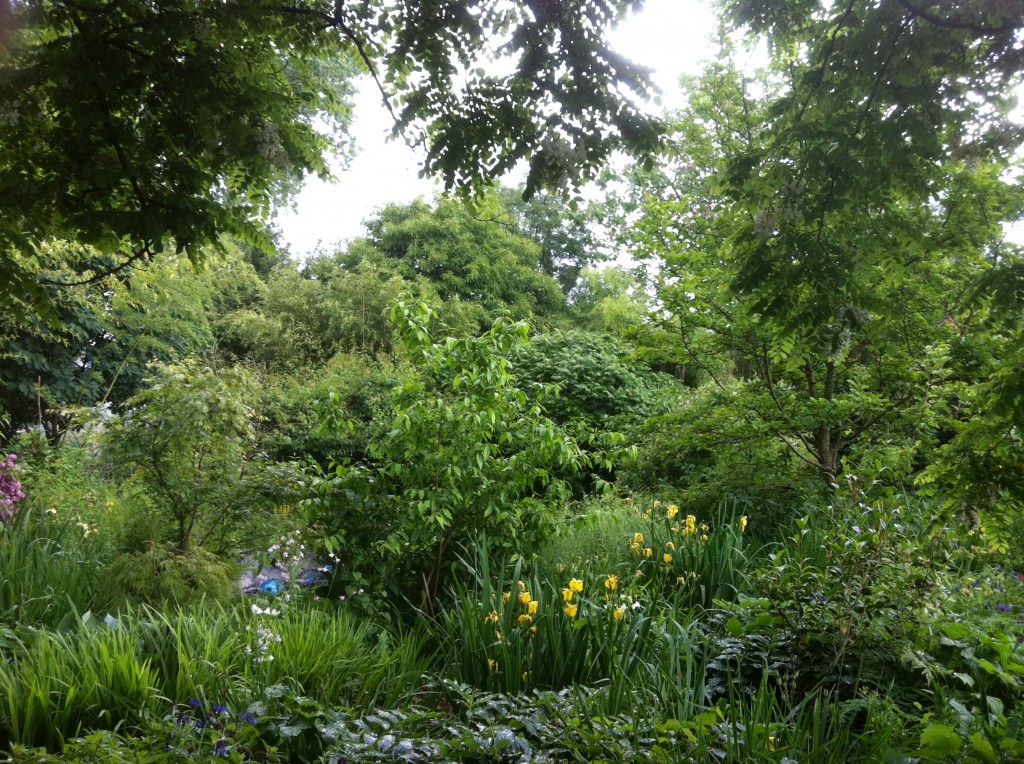 what we stand to lose If you’d like to weigh in on this issue and help prevent Vision from making a terrible mistake, here are some links:
‘Save Cottonwood’ Facebook group:
http://www.facebook.com/SaveCottonwoodCommunityGarden
‘Save Cottonwood’ Twitter feed:
https://twitter.com/SaveCottonwood
Geoff Meggs e-mail:
clrmeggs@vancouver.ca
Gregor Robertson e-mail:
gregor.robertson@vancouver.ca
Mayor and Council e-mail:
mayorandcouncil@vancouver.ca
(this isn’t the greatest way to get attention. It’s much more useful to e-mail individual councillors directly)
Here is a link to all the individual City Council contacts:
http://vancouver.ca/your-government/city-councillors.aspx
Also here is a link to my own history of Cottonwood:
http://www.oliverk.org/page/cottonwood-community-gardens
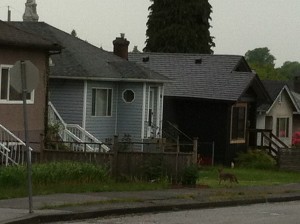
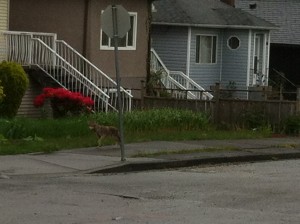
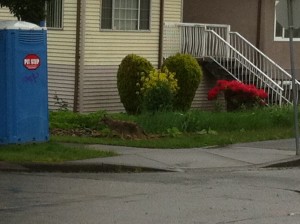
The steady incursion of the coyote into North American cities is an outstanding example of the kind of hyper-ecologies I am interested in. Though it is native, the coyote evolved as an interstitial species, having to eke out a living in the ecological between the wolf and the fox, and so it always had to be adaptable. Vacant industrial lands and suburban cul-de-sacs have become as much home to the coyote as the arroyos and sage steppes of its traditional habitats, but they offer rich new food sources in the form of ubiquitous garbage and dim-witted house pets. Quick to learn and selectively omnivorous, the coyote thrives in the wreckage of wilderness, where its larger cousin the wolf has been largely extirpated.
Among the sidewalks and rhododendrons and stupendously overpriced little stucco houses of East Vancouver, I was charmed to come across one of these clever canids, making its rounds; methodically investigating the driveways and gaps between houses for a chance at some badly packed trash or a succulent, over-fed cat. I followed it for, a while and though it seemed well aware of my presence, it maintained just enough distance to continue with its nonchalant foraging, never once breaking its stride. Despite our fantasies of control over our built environments, there is no doubt in my mind who will ultimately inherit them. Whether tearing into our garbage or chewing on our bloated corpses, the coyote will surely outlast us. Whether we like it or not, the future is feral…
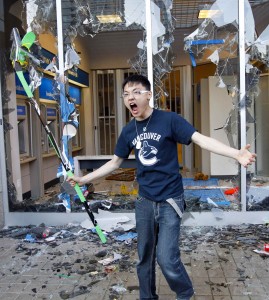 the joy of authenticity
As post-hockey riot Vancouver sweeps the last shards of glass from its sidewalks and processes a myriad insurance claims, the hand-wringing and finger pointing are proceeding apace in the mad rush to save the reputation of the so-called ‘most livable city on earth.’
But my question is – why were we so surprised?
To make sense of the images of water-polo playing sons of surgeons setting fire to police cars and private school toffs rampaging through the ruins of bank lobbies, we might learn more from the words of a dead science fiction writer than from any of the outraged utterances of the mayor and the chief of police.
J.G. Ballard would have loved this riot. In fact he consistently imagined situations like this (and worse) in his dystopian novels and short fiction. In his novella Running Wild, the children in a gated community of middle class professionals band together and slaughter their parents within the tasteful grounds and interiors of their designer homes. In High Rise, the residents of a luxury apartment tower wage tribal warfare against rival floors in an effort to alleviate the boredom of their cosseted and privileged lives.
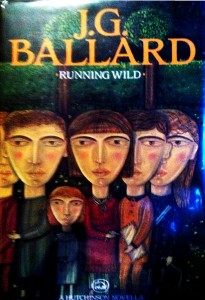 My copy of 'Running Wild'
“Unable to express their own emotions or respond to those of people around them, suffocated under a mantle of praise and encouragement, they were trapped forever in a perfect universe. In such a society, madness is the only freedom.”
J.G. Ballard: Running Wild (1988.)
In many ways Vancouver’s hockey riot was likewise an expression of raging bourgeoise ferality; essentially, a riot about nothing – a ‘Seinfeld’ of riots to which it is a mistake to ascribe any political motive. In the wake of the play-off defeat, with the Canucks scoring ‘zero,’ something had to take the place of that nothing even if that something was pointless violence. At least that could be remembered, tweeted and socially networked. To read any more into this is to be mistaken, yet for me, the underlying message is clear:
Beware of the middle class.
Especially its young men. For they exist increasingly in a state that could be described as a deficit of the real, which is dangerous and unstable place, full of unfocused outrage and an overdeveloped sense of personal entitlement that constantly simmers just below the surface. The riot wasn’t a conspiracy of any kind but rather the lack of one – a set of preconditions where a massive charge of nothingness had accumulated to which the riot was an almost electrical response; the closing of a circuit to the unmet expectations of an ontologically bereft, predominantly suburban, mob. With the loss of the game, the value of the Canuck brand (temporarily) evaporated for them, triggering a wave of buyer’s remorse through the hyped-up expectations of the crowd. In the brutal logic of the situation, the outpouring of rage had to be taken out on the city itself, the brand’s associative container. In that sense the ubiquitous slogan: ‘We are all Canucks,’ proved truer than it needed to be. The ensuing riot and looting were pure reification, a desperate desire to wrest meaning from the void, to be part of an authentically ‘real’ experience outside the purview of the corporate machine that had so spectacularly failed to deliver. No matter how one feels about it, the hockey riot unarguably ‘happened,’ the physicality of its burned-out automobiles and pillaged storefronts comprising an iconic collective experience that will be remembered for a long time to come, despite the almost immediate attempts by civic boosters to re-narrative-ize it by drawing media attention to isolated acts of heroism and the bonhomie of those engaged in the clean up effort.
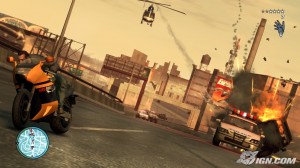 Grand Theft Auto
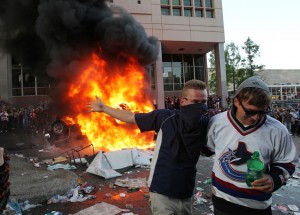 sports fan ferality
The Stars of the Riot:
White Riot – I wanna riot
White Riot – A riot of my own
The Clash – White Riot 1977
But getting back to the situation of those young, suburban men…
What would prompt a privileged Maple Ridge kid like 17 year-old Olympic hopeful, Nathan Koytlak to be photographed in front of a cheering crowd, holding a lighter and stuffing a rag into the gas tank of a police cruiser?
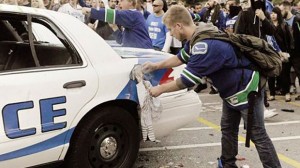 he's 'caught up in the moment' Not to pick on young Nathan, who like so many others has issued his legally-vetted and suitably contrite public apology. In keeping with his class privilege, Nathan’s ‘brand of one’ might someday be rebuilt, but such scenes were played out countless other times, the perpetrators more or less interchangeable, all of them egged-on by appreciative, live-blogging audiences recording each detail on a panopticon of socially networked devices. In a sense the individual stars of the riot, served as avatars for the feral aspirations of the many, a kind of crowd-sourced, ‘Vancouver’s Got Talent,’ reality TV show, where in order to distinguish themselves, participants vied against each other in contests of escalating ‘bad-assedness.’
There are parallels also with computer gaming, though it would be too simplistic to call it a cause. One wonders if the ubiquitous Grand Theft Auto trope of flames and pixelated blood spatter against the backdrop of a burned out city has so thoroughly colonized the optical subconscious that it now seems natural somehow, even reassuring, a kind of default habitat where young men in particular are used to operating. The post play-off anomie created the perfect psychological environment for the unleashing this pent-up, first-person-shooter energy against the bland, manufactured seamlessness of the theme-parked urban landscape, every broken window and burned-out car as unique as a snowflake and a marker of the perpetrator’s now extended personal space.
Lek Behavior:
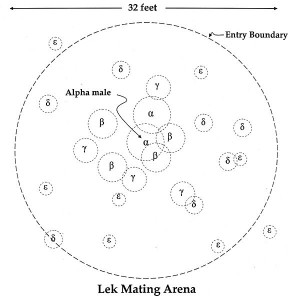
And what of the grand old game itself? Much ink has been spilled about the gratuitous violence in professional hockey. But it isn’t hockey per se. As in other sports, there is an obvious mimetic component that compels some spectators to re-enact the gladiatorial dynamic of the game outside the confines of the arena. This isn’t exactly new. Sports riots have been recorded from as far back as Roman times and have more to do with tribal rivalry than anything intrinsic to specific games. Soccer isn’t a particularly violent sport but English football hooligans are some of the most brutal fans on earth. That team sports serve as a kind of proxy combat onto which spectators project their own polemical aspirations is well known, and the environment around high stakes matches can provide ideal conditions for territorial violence by concentrating large numbers of adrenally stimulated and often intoxicated young males into confined spaces. The resultant eruptive behavior closely resembles a form of animal territorial display called ‘lekking,’ prevalent in such species as sage grouse and certain ungulates. It works (to paraphrase Wikipedia) like this:
In a lek, males of the same species meet at a preordained place (actually called an ‘arena’) and take up individual positions, each occupying and defending a small territory or ‘bubble’ where they intermittently or continuously spar with their neighbors or put on extravagant visual or aural displays. The higher the male’s status, the larger the size of the bubble he can occupy and the better and more central its location. Physical contests in these situations are frequent and females choose their mates in accordance with their dominance.
By funneling crowds containing a large proportion of young men into the so called ‘fan zone,’ the city of Vancouver unwittingly created the perfect conditions for an enormous, testosterone-charged lek. From the standpoint of biology, the mayhem that ensued was pretty much inevitable.
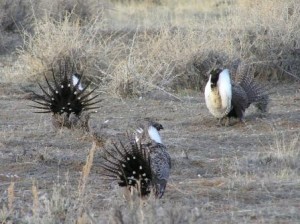 sage grouse lekking behavior The only surprise to this whole sorry debacle was that police and civic officials were so woefully under-prepared. Though a similar situation had occurred back in 1994, the city was once again caught on the back foot. One can only speculate as to why. Against its spectacular backdrop of snow capped mountains and unspoiled forest verdure, the haze of magical thinking frequently occludes acknowledgement of some of Vancouver’s most pressing problems. This isn’t anyone’s fault in particular, but a kind of climatic reality – an endemic social viscosity and an overarching cultural attachment to the pursuit of personal bliss. The result, unfortunately is that some pretty big issues get swept up under the rug. The riot of 2011 affords this odd, little adolescent city an opportunity to take stock and finally begin to grow up. Let’s hope that happens soon.
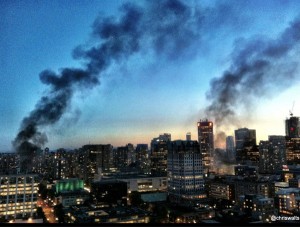 the future is feral
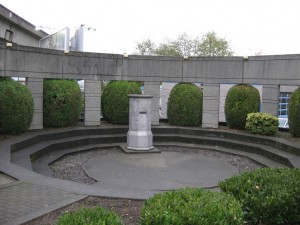 monument to nothing I wanted to bring to your attention Vancouver’s lovely, lonely ‘Monument to Nothing,’ whose emptiness is free for all to adore and onto which, in the eye of our minds, we can project the objects of our deepest adulation. I’m standing in its sunken piazza, watching an empty shopping cart rattle against the circular steps with the tail wind of every passing transport truck. The pavement shudders and the diesel soot billows in the tormented air like the thought bubbles of demons. Around me, a ring of brutalist concrete tees that stand astride stymied balls of topiary. A nod perhaps to the Roman colosseum or the classical amphitheater? But then again, maybe not.
I love this place. I came here on a pilgrimage to remember the things I never knew. Like the silverfish, which can live for a year without eating but prefer instead a diet of dandruff and carpet fibers. I remember a bronze head that was never here. I’d thought I’d seen it years ago, out of the corner of my eye, a jowly visage in medieval headgear. I even took it for granted. But no, it wasn’t. Not ever. Here.
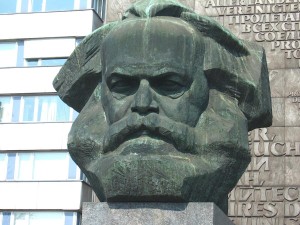
Karl Marx’s head was never here
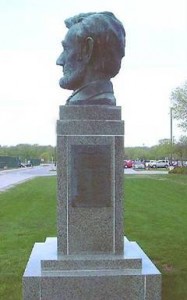
Lincoln’s head was never here either
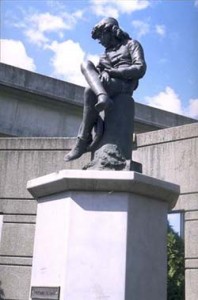
he was here for a while
What was here, though? I felt the need for research, which always feel like the man rolling up his sleeve about to slide his wrist into the cheesecloth cage of hungry mosquitoes. “They don’t bite – they don’t even light!” Only sometimes they do. And then you die. Of malaria. Or dengue fever. Or any of the other assorted little ills that, if you are famous enough in life, might get a monument to you erected after you kick the bucket. Take Christopher Columbus – Admiral of the Ocean Sea; Viceroy and Governor of the Indies. We don’t know how he died. Maybe it was syphilis, the vexing stowaway that snuck its way to Europe in the pants of his sailors. It was this Columbus who, once upon a much later time, sat for a while, perched on a lonely plinth, gazing out wistfully over Clark Drive’s seething traffic, a continent away from the sea he once crossed, his back turned to another ocean – the one he never imagined in his lifetime. And not just his disembodied head, the way I’d misremembered it, but his entire gangling body too, as it appeared, or was thought to have appeared in the days of his callow youth, when he was just a proto-Columbus, who hadn’t yet sailed the ocean blue, or even likely thought about it. Is that nothing? It’s not nothing, but it’s barely something. Soon barely something became nothing again, when the sculpture disappeared, seconded by a cadre of mysterious Italian-Canadian aesthetes who kept the bronze boy wonder sequestered for several months before relocating him to the more commodious environs of Hastings Park. So Clark Drive’s monument to nothing remains as such, free from any distracting somethings, empty and beautiful for all of us to think about that which once was but is no longer or maybe, never was at all.
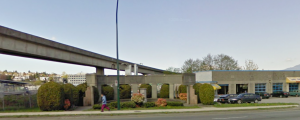 nothing is as beautiful as this...
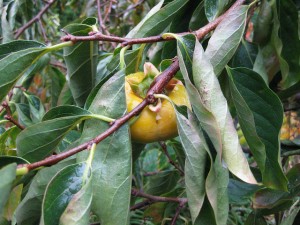
Russian persimmons at Cottonwood
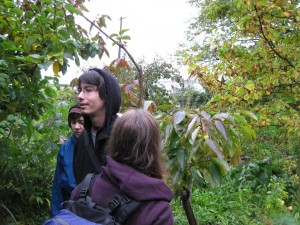
Inspecting Persimmons
One of the delights of late autumn is the sweet taste of persimmon. Almost 20 years ago, when I was first designing the Asian arboretum at the brand new Cottonwood Community Gardens, I ordered a few small, bare-root trees from a nursery called Oregon Exotics. Its proprietor, Jerome R Black, described himself as a peripatetic ethno-botanist and his catalog featured a diversity of rare plant varieties I hadn’t seen anywhere else. He collected many of the parent plants himself, in remote areas of Asia and South America, where he traveled in search of overlooked crops worth trying in warmish temperate climates. Vancouver, with its relatively cool and wet weather is at the northern edge of where persimmons might be expected to flourish, so I selected three varieties from his listings – ‘Russian,’ ‘Korean,’ and ‘Great Wall,’ which were described as cold tolerant and early maturing. Cottonwood Gardens is situated in a kind of urban heat island, so I had high hopes of seeing the fruit ripen, in time for the torrential rains of fall. The trees got off to a slow start, but after three years or so, the first fruits appeared. Life brought about its inevitable changes and after I moved away to New York City (and eventually Cortes Island), I wasn’t able to check in with my former botanical charges nearly as often as I would have liked.
While I was back in Vancouver a couple of weeks ago, I got to hang out with of the Purple Thistle Collective. They are a youth group who are doing amazing work farming the parking strips of East Van’s industrial zone. Their gonzo, earth-repair spirit reminded me of when we first started Cottonwood, which is in the same area, some 20 years ago.
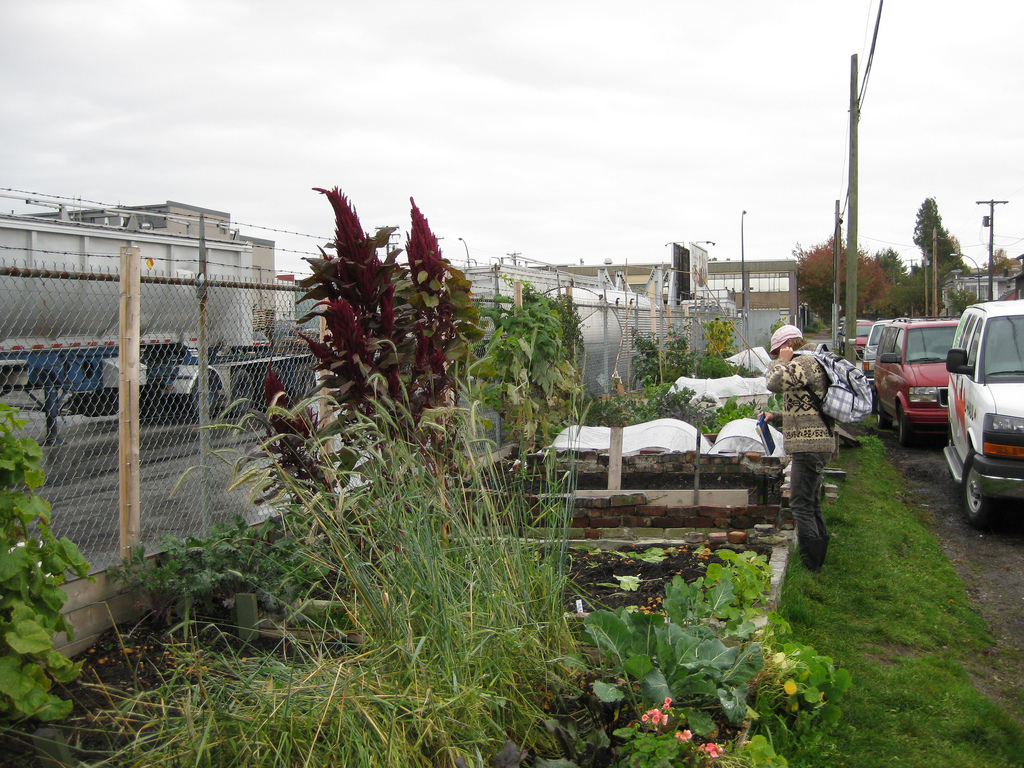
Purple Thistle's Industrial Zone farming
In addition to being guerrilla gardeners, the gang at the Thistle turn out to be Super 8mm film geeks, determined to bring the endearingly crusty medium back to a whole new generation of enthusiasts. There is something particularly endearing about these teens and twenty-somethings, raised in the great smothering bosom of the Internet, seeking to re-vivify Super 8, with all of its grainy unpredictability and lack of instant gratification. Viva Analog!! I’ll be pulling some of my ‘Haute Cold War’ footage from the vault soon to screen for them, – stuff I shot in Berlin, Toronto and New York, in the early 1980’s. There is a sequence they might like, which shows the thriving DMZ ecology of the no-man’s land in between the two sections of the Berlin Wall – a mine field covered in lush meadow that supported a teeming population of hares, which in turn were preyed upon by a proliferation of raptors.
Anyway, back to the persimmons. When the Thistles and I trooped over to look at the plantings in Cottonwood, I was happy to see the persimmon trees bearing better than ever, their shiny leaved branches, bobbing in the November drizzle with jaunty orange fruits. For those of you who have never eaten a persimmon, some caution is in order. Fuyu, type persimmons taste sweet even when not completely ripe but many others, such as the popular Hachiya, need to be quite soft before you eat them, otherwise your mouth will feel like you’ve just sucked on a deodorant stick, – a saliva-less gaping hole through which you will have to beg for water. Well not quite that bad, but the fruit-fancier’s description of ‘astringent’ is well worth noting. When sufficiently ripened though, these persimmons are sheer ambrosia. Though native to the Far East, these ‘kaki’ type persimmons (Diospyros kaki), have a long history of cultivation in the Mediterranean. Over the years, I’ve noticed quite a few of these trees popping up in East Vancouver, usually in the yards of Italian immigrants, and many of them seem to be producing well. Given the right location and a bit of care, Asian persimmons should thrive in at least the mildest parts of Canada. The related American persimmon (Diospyros virginiana) is native to areas not that far south of the Great Lakes and can stand quite a bit of cold. Clearly some experimentation is in order. Grimo Nut Nursery offers some varieties they say do well in Southern Ontario, which might be worth a try in other mild-ish areas as well.
I’ve grown quite a few persimmon trees from seed over the years, though none have yet reached fruiting size. The trick is to let the seeds overwinter outside or in a fridge, to stimulate germination the following spring. I put them into a zip-lock bag with a bit of soil, in a spot where rodents can’t get at them. I’ve got a couple of Diospyros lotus seedlings, also known as Date plums, growing in my Cortes Island yard. I originally propagated them from a fruit I picked up from the path in the Brooklyn Botanical Garden. The trees, though small, seem to be doing well and haven’t yet been set back during the past few winters. The fruits of the parent tree were quite small as I recall, not exactly the ‘food of the gods,’ implied by their Latin name – unless of course the gods were not particularly discerning fruit-wise. Odysseus’s men were said to have been way-laid by them in the land of the lotus eaters. Maybe the fruits were larger in those days or maybe Odysseus and his gang were tiny midget people the size of human thumbs. Probably though, his sailors just got bored of being told to “smite the gray seas with their oars,” by their hard-ass captain and were holding out for a little well-deserved ‘R and R.’ So my date plums will likely be relegated to my ever expanding collection of ‘somewhat edible’ plants, an aspect of my gardening hobby that my significant other continues to find perplexing.
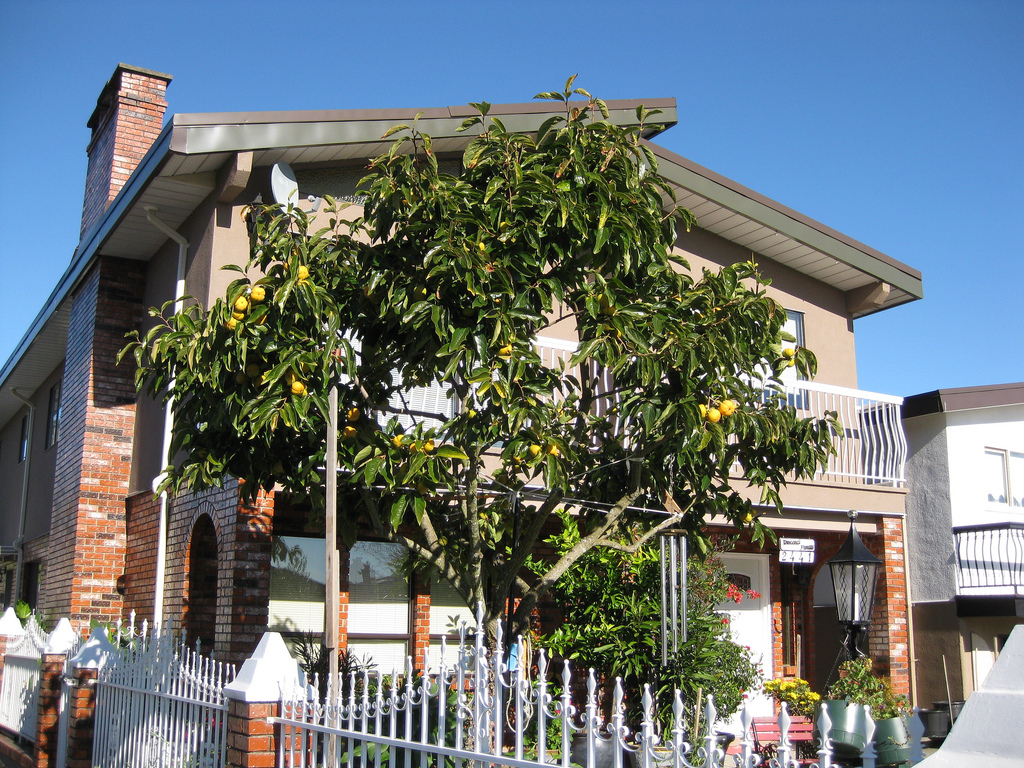
East Van persimmon – 5th & Nanaimo
|
|































